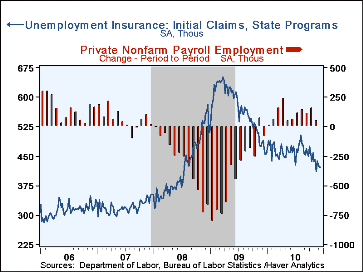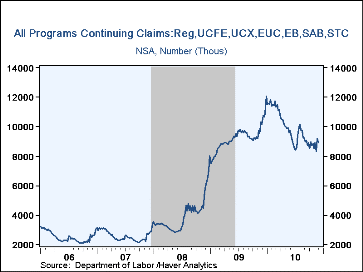 Global| Dec 23 2010
Global| Dec 23 2010U.S. Initial Unemployment Insurance Claims Decline
by:Tom Moeller
|in:Economy in Brief
Summary
Initial claims for unemployment insurance slipped last week to 420,000 from 423,000 during the prior period (revised from 420,000). The four-week moving average ticked up to 426,000, still near the lowest since July 2008. The latest [...]
 Initial claims for unemployment insurance slipped last week to 420,000
from 423,000 during the prior period (revised from 420,000). The four-week
moving average ticked up to 426,000, still near the lowest since July 2008. The
latest weekly figure matched Consensus expectations. The latest figure covers
the survey period for December payroll employment and claims fell 21,000 (-4.8%)
from the November period. During the last ten years there has been a 74% inverse
correlation between the level of claims and the m/m change in private sector
nonfarm payrolls.
Initial claims for unemployment insurance slipped last week to 420,000
from 423,000 during the prior period (revised from 420,000). The four-week
moving average ticked up to 426,000, still near the lowest since July 2008. The
latest weekly figure matched Consensus expectations. The latest figure covers
the survey period for December payroll employment and claims fell 21,000 (-4.8%)
from the November period. During the last ten years there has been a 74% inverse
correlation between the level of claims and the m/m change in private sector
nonfarm payrolls.
Continuing claims for state-administered programs fell a sharp 103,000 in the December 11 week to 4.064M. They were the lowest since November 2008. The associated unemployment rate slipped to 3.2%, also the lowest since November 2008. These claimants are, however, only about half of the total number of people currently receiving unemployment insurance. Regular extended benefits, with eligibility dependent on conditions in individual states, rose to 893,016 on December 4, the latest figure available; renewed federal funding may see this number increase again in coming weeks. The other extra program, Emergency Unemployment Compensation program, referred to as EUC 2008, also had a reduced 3.786M beneficiaries.
A grand total of all claimants for unemployment insurance includes extended and emergency programs and specialized programs covering recently discharged veterans, federal employees and people in state-run "workshare" programs, among others. All together, on December 4, the total number of all program recipients was 8.884M, off 12.7% y/y. Two other programs, disaster unemployment assistance (DUA) and trade readjustment allowance (TRA), are reported through a different Labor Department channel and lag by an additional week. This even more comprehensive total including those equaled 9.198M in the November 26 week, down 10.7% from a year ago. These individual program data are not seasonally adjusted.
Data on weekly unemployment insurance programs are contained in Haver's WEEKLY database and summarized monthly in USECON. Data for individual states, including the unemployment rates that determine individual state eligibility for the extended benefits programs and specific "tiers" of the emergency program, are in REGIONW, a database of weekly data for states and various regional divisions.
| Unemployment Insurance (000s) | 12/18/10 | 12/11/10 | 12/04/10 | Y/Y % | 2009 | 2008 | 2007 |
|---|---|---|---|---|---|---|---|
| Initial Claims | 420 | 423 | 423 | -10.4 | 572 | 419 | 321 |
| Continuing Claims | -- | 4,064 | 4,167 | -21.6 | 5,809 | 3,340 | 2,549 |
| Insured Unemployment Rate(%) | -- | 3.2 | 3.3 | 3.9 (12/09) |
4.4 | 2.5 | 1.9 |
| Total "All Programs" (NSA)* | -- | -- | 8,883,578 | -12.7% | 9.170M | 3.931M | 2.634M |
*Excludes disaster unemployment assistance and trade readjustment allowance
Tom Moeller
AuthorMore in Author Profile »Prior to joining Haver Analytics in 2000, Mr. Moeller worked as the Economist at Chancellor Capital Management from 1985 to 1999. There, he developed comprehensive economic forecasts and interpreted economic data for equity and fixed income portfolio managers. Also at Chancellor, Mr. Moeller worked as an equity analyst and was responsible for researching and rating companies in the economically sensitive automobile and housing industries for investment in Chancellor’s equity portfolio. Prior to joining Chancellor, Mr. Moeller was an Economist at Citibank from 1979 to 1984. He also analyzed pricing behavior in the metals industry for the Council on Wage and Price Stability in Washington, D.C. In 1999, Mr. Moeller received the award for most accurate forecast from the Forecasters' Club of New York. From 1990 to 1992 he was President of the New York Association for Business Economists. Mr. Moeller earned an M.B.A. in Finance from Fordham University, where he graduated in 1987. He holds a Bachelor of Arts in Economics from George Washington University.








